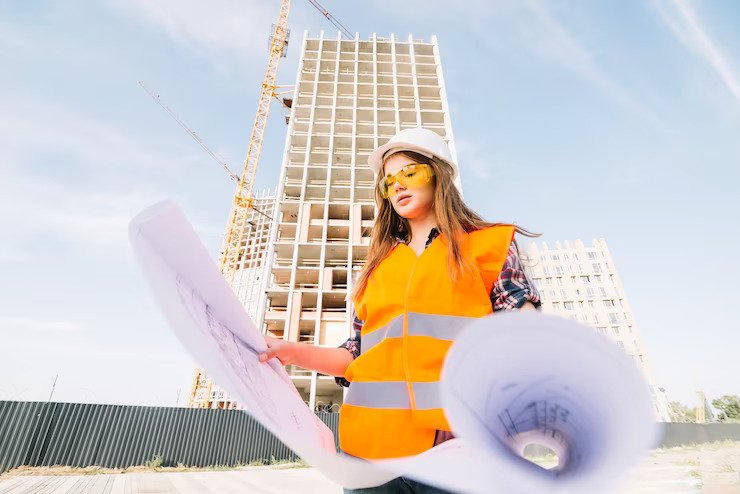Women In Construction: Breaking Down Barriers And Advancing Careers

Construction has long been considered a male-dominated field, with men making up the majority of the workforce. However, women are increasingly playing a critical role in the construction industry, and their importance cannot be overstated.
As the construction industry continues to grow and evolve, it is essential to recognize the significant contributions that women bring to the table. Women are making their mark in fields that have historically been controlled by men, from architecture and engineering to project management and skilled trades.
Despite this progress, women still face a number of challenges when it comes to pursuing construction jobs here. The gender gap in construction remains significant, with women comprising only 9% of the workforce. This disparity is largely due to deep-rooted gender stereotypes and cultural barriers that can discourage women from pursuing careers in this field.
However, the industry is taking steps to promote greater diversity and inclusivity, recognizing the important role that women can play in shaping the future of construction. From providing mentorship and training opportunities to offering more flexible work arrangements, there are many ways that companies can help women succeed in construction.
In the following sections, we will explore the historical background of women in construction, the current status of women in the industry, the barriers they face, and the strategies and solutions for encouraging more women to pursue construction jobs and advance their careers in this exciting field.
Historical Background
The role of women in construction dates back centuries, although their contributions have often been overlooked or undervalued. Women have played a vital role in building and maintaining communities, from helping to construct homes and buildings to providing support in times of crisis.
However, it was not until the mid-20th century that women began to enter the construction industry in significant numbers. During World War II, women were called upon to take on a variety of jobs traditionally held by men, including construction work. Many women found that they enjoyed this type of work and continued to pursue careers in construction after the war ended.
Despite these early pioneers, women still face significant barriers when it comes to pursuing careers in construction. The gender gap in the industry is significant, with women comprising just 9% of the workforce. Women are underrepresented in almost every area of construction, from management and engineering to skilled trades.
The reasons for this gender gap are complex, but they are largely due to a combination of cultural and structural barriers. Women are often discouraged from pursuing careers in construction due to gender stereotypes that associate the industry with physical labor and male-dominated work environments. Additionally, women face systemic barriers in terms of hiring and promotion, as well as discrimination and harassment on job sites.
Despite these challenges, women in construction are making their mark and paving the way for future generations of women to succeed in this exciting field. In the following sections, we will explore the current status of women in construction, the barriers they face, and the strategies and solutions for advancing their careers and breaking down barriers in the industry.
Current Status of Women in Construction

Although women have made significant strides in the construction industry in recent years, they still face many challenges and barriers to success. Only nine percent of construction workers are women, per NAWIC (National Association of Women in Construction).
This underrepresentation is particularly acute in management and leadership roles, where women are even less likely to be represented. Women in construction also face significant wage gaps, earning only 81 cents on the dollar compared to their male counterparts.
One of the biggest challenges that women face in construction is the culture of the industry. Construction sites are often seen as male-dominated environments, where women are viewed as outsiders. This can lead to discrimination, harassment, and even physical danger on job sites. Women may also struggle to find mentors or networking opportunities within the industry, which can make it difficult to advance their careers.
Another major challenge is the lack of flexibility in many construction jobs. Women are more likely to have caregiving responsibilities, such as caring for children or elderly relatives, which can make it difficult to work long hours or travel frequently for work.
Despite these challenges, women in construction are breaking down barriers and making their mark in the industry. Many companies are recognizing the importance of promoting diversity and inclusivity, and are taking steps to create more welcoming and supportive work environments for women. In the next section, we will explore the barriers that women face in construction in more detail, and discuss strategies for breaking down those barriers and advancing women’s careers in this exciting field.
Barriers to Women in Construction
Women who are interested in pursuing careers in construction face a range of obstacles that can make it difficult to enter the industry and advance their careers.
Some of the most significant barriers include:
- Gender stereotypes: The construction industry has long been associated with physical labor and masculine work environments. This can lead to gender stereotypes that discourage women from pursuing careers in construction. Women may be viewed as less capable or less committed than their male counterparts, simply because of their gender.
- Lack of support: Women in construction may struggle to find support and mentorship within the industry. This can make it difficult to advance their careers and can lead to feelings of isolation and frustration.
- Discrimination and harassment: Women in construction are often subject to discrimination and harassment on the job site. This can range from subtle forms of bias to outright hostility and intimidation.
- Lack of flexibility: Many construction jobs require long hours and travel, which can be difficult for women with caregiving responsibilities. This can make it difficult for women to balance their work and family obligations.
- Few role models: Women who are interested in pursuing careers in construction may struggle to find female role models within the industry. This can make it difficult to envision themselves succeeding in the field and can lead to feelings of discouragement.
Despite these obstacles, women in construction are making significant progress in breaking down barriers and advancing their careers. In the next section, we will discuss strategies for overcoming these barriers and creating a more welcoming and supportive environment for women in construction.
Strategies for Encouraging Women to Enter Construction

To address the underrepresentation of women in construction, companies and industry organizations can take a number of steps to attract and recruit more women into the field. Here are some strategies that have been successful in encouraging women to pursue careers in construction:
- Outreach and recruitment: Companies can actively seek out and recruit women for construction jobs. This can include attending job fairs and college recruiting events, advertising in publications and on social media channels that are popular with women, and partnering with community organizations to reach out to women who may be interested in construction careers.
- Education and training: Providing training and education opportunities can help women develop the skills they need to succeed in construction. This can include apprenticeships, job shadowing, and mentoring programs that provide women with hands-on experience and exposure to different roles within the industry.
- Flexible work arrangements: Companies can offer flexible work arrangements that make it easier for women to balance their work and family responsibilities. This can include flexible schedules, job sharing, and telecommuting options.
- Supportive work environments: Companies can create more supportive work environments that promote diversity and inclusivity. This can include offering diversity training, promoting gender equity in hiring and promotion practices, and creating employee resource groups that provide support and mentorship to women in the industry.
- Showcasing successful women in construction: Highlighting the achievements of successful women in construction can help to break down gender stereotypes and encourage more women to consider careers in the industry. Companies can feature successful women in their marketing materials and on their websites, and they can also sponsor awards and recognition programs that celebrate the accomplishments of women in construction.
By implementing these strategies, companies can help to create a more diverse and inclusive construction industry that offers opportunities for women to succeed and advance their careers.
Conclusion
As we have seen, women have historically been underrepresented in the construction industry, facing numerous barriers to entry and advancement. However, there are many successful women who have made significant contributions to the field and proven that women have a place in construction.
It is important to recognize the value that women bring to the industry, including their unique perspectives, skills, and experiences. By increasing the representation of women in construction, we can create a more diverse and inclusive industry that is better equipped to meet the challenges of the future.
To achieve this goal, we must take action to support and encourage women in construction. This includes providing education and training opportunities, offering flexible work arrangements, promoting diversity and inclusivity in the workplace, and highlighting the achievements of successful women in the field.
As we move forward, let us commit to creating a more equitable and inclusive construction industry that offers opportunities for all. By working together, we can break down the barriers that have held women back and build a better future for all those who work in construction.
Read Also:










